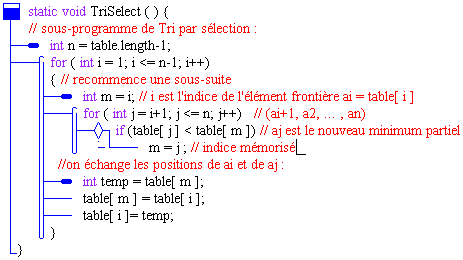Une classe
Java solution du problème :
Le sous programme Java implantant l'algorithme de tri par sélection
:

Une classe complète permettant l'exécution du sous-programme
précédent :
class ApplicationTriBulle {
static int[] table
= new int[20] ; // le tableau à
trier : 20 éléments |
static void AfficherTable
( ) {
// Affichage du tableau
int
n = table.length-1;
for
(
int
i = 1; i <= n; i++)
System.out.print(table[i]+"
, ");
System.out.println();
}
static void InitTable
( ) {
// remplissage aléatoire
du tableau
int
n = table.length-1;
for
( int i = 1; i <= n; i++)
table[i]
= (int)(Math.random()*100);
}
static void main(String[ ] args)
{
InitTable ( );
System.out.println("Tableau
initial :");
AfficherTable ( );
TriSelect ( );
System.out.println("Tableau
une fois trié :");
AfficherTable ( );
} |
static void TriSelect ( ) {
// sous-programme
de Tri par sélection : on trie les éléments du n°1
au n°19
int
n = table.length-1;
for
( int i = 1; i <= n-1; i++)
{ // recommence une sous-suite
int m = i; // i est l'indice de
l'élément frontière ai = table[ i ]
for ( int j = i+1; j <= n; j++)
// (ai+1, a2, ... , an)
if (table[ j ] < table[ m ]) //
aj est le nouveau minimum partiel
m = j ; // indice mémorisé
//on échange les positions de ai et de aj :
int temp = table[ m ];
table[ m ] = table[ i ];
table[ i ] = temp;
} |
} |
Image en diagrammes structurés JGrasp-Like du programme

informations sur les diagrammes
 Source
recopiable (cliquez sur le lien)
Source
recopiable (cliquez sur le lien)
Tableau initial :
53 , 77 , 11 , 72 , 28 , 43 , 65 , 83 , 39 , 73 , 82 , 69 , 65 , 4
, 95 , 46 , 12 , 87 , 75
Tableau une fois trié :
4 , 11 , 12 , 28 , 39 , 43 , 46 , 53 , 65 , 65 , 69 , 72 , 73 , 75
, 77 , 82 , 83 , 87 , 95
Remonter 

![]()
![]() Source
recopiable (cliquez sur le lien)
Source
recopiable (cliquez sur le lien)